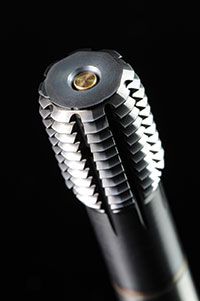by Sam Matsumoto
Recent advances have overcome past limitations
Traditionally, form tapping was used for non-ferrous and common steels (below 30 HRC). Work material needed to be pliable to displace it into a thread effectively.
Rolling a thread also required significantly more machine torque compared to cutting, and because of that, larger diameters were nearly impossible to thread form.
Combined, these factors limited the range of applications for form taps.
However, recent advances have overcome these limitations. New developments in tap substrate, design and tool coating decrease friction significantly and enable harder materials up to 40 HRC to be formed. Even some HRSA materials can be thread formed.
Typically, thread forming is difficult for larger threads (over 19 mm/ ¾ in. or M20) because of high tapping torque, friction and machine power requirements. New designs reduce this torque and friction and maintain a low machine spindle load, making them ideal for larger threads (up to 44.45 mm/1-3/4 in. or M45). The benefits of these new designs also mean it’s now possible to form tap deeper holes, which in the past were a challenge due to chip generation.
With reduced heat generation comes the ability to use water soluble coolants, replacing oil as a lubricant for non-stainless steel applications. However, non-water soluble coolants are still recommended for thread forming stainless steels due to the material’s inherent tendency to stick and build up on the tool itself. Non-water soluble coolant also helps to further reduce friction in stainless steel applications.
Adding an option of coolant through the tap enables high speed operations and results in higher tool life. Even MQL can be applied effectively to these coolant through tools.
Despite the many benefits and advances in form tapping, it’s important to note some industries, such as aerospace, medical and food, are not able to utilize this thread form. This is due to the difference in actual thread form between a rolled and cut thread.
 When an internal thread is formed, a slit is created and makes a hollow cavity. This cavity can become embedded with water or oil, which may freeze and crack the thread under extreme environments. Potentially, these spaces can also fill with organic debris and result in unsanitary conditions.
When an internal thread is formed, a slit is created and makes a hollow cavity. This cavity can become embedded with water or oil, which may freeze and crack the thread under extreme environments. Potentially, these spaces can also fill with organic debris and result in unsanitary conditions.
One challenge of form tapping is controlling the internal thread minor diameter. It’s especially difficult if there is a specific minor diameter tolerance that needs to be achieved and maintained.
Work materials have their own individual characteristics which may react and form differently. Combined with other variables such as part feature design, coolant type and concentration, machine alignment, spindle and tool holder accuracy, dialing in the correct size isn’t always easy.
The tap drill in a cut tap application controls the minor diameter. The tap itself does this in a formed thread. The amount of material left to form by the tap drill is key to achieving the specified minor diameter for any rolled thread application.
Sometimes the solution is through trial and error.
When a tool manufacturer recommends a specific tap drill size, it’s based on a nominal range. To achieve a specific minor diameter, it may be necessary to choose a slightly different drill diameter. By pin gauging the threaded hole after each different tap drill size, you will be able to pinpoint your targeted thread minor diameter. SMT
Sam Matsumoto is an application engineer with OSG Canada Ltd.
